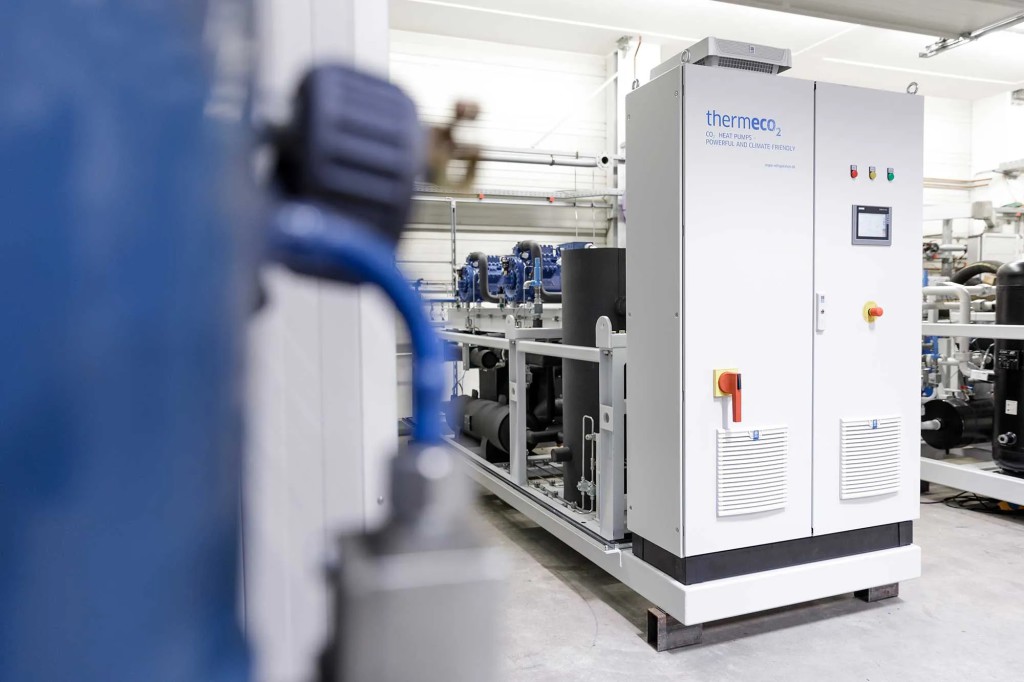A fitting reminder on heat pumps

There is a compelling environmental case for switching from fossil fuel-based heating to heat pumps in commercial premises but Tim Mitchell, Sales Director of Klima-Therm, says there are many factors to consider in order to do this successfully.
Despite recent indications from Prime Minister Rishi Sunak that he plans to soften the UK’s environmental objectives, the country has set a legally-binding target to reach net zero greenhouse gas emissions by 2050.
Achieving this will require almost all heat in buildings to be decarbonised, as well as heating-related carbon emissions in industry to be reduced to virtually zero.
The electrification of heat in the form of heat pumps has smoothed the path towards ‘cleaner’ temperature control. Indeed, it is widely acknowledged that heat pumps should be the primary technology choice for decarbonising heat in existing buildings.
The reasons are simple. An efficiently-designed, installed and operated heat pump system can deliver immediate CO2 emissions savings of up to 70% compared to conventional electric heating and between 55% and 65% compared to an efficient gas boiler.
The Carbon Trust has stated that as the grid decarbonises further in coming decades, the carbon savings delivered by heat pumps are expected to increase further, towards 90% or 100% CO2 emissions reductions by 2050.
Integrating heat pumps into new commercial buildings is more straightforward than installing them in refurbishment projects.
However, switching efficiently from fossil-fuelled heating (generally gas-fi red boilers) to heat pumps in larger buildings (typically those with a thermal output of more than 45kW) does present significant challenges. Heat pumps are not a like-for-like replacement for gas boilers or conventional electric heating, and that’s why effective system design is essential.
The Carbon Trust has stated that a key difference between heat pumps and traditional forms of heating is that heat pumps operate most effi ciently at lower flow temperatures.
It went on to say that some energy-efficient buildings can already accommodate lower temperature heat and many heat pumps can deliver higher temperature heat. However, optimising performance will often require upgrading the heat emitters (such as radiators) and reducing heat loss through the thermal fabric of the building.
“In this sense, heat pumps require a greater focus on the holistic energy performance of the building and best practice design involves minimising heat losses as well as optimising supply,” the organisation says.
Important differences
Another important differentiator between heat pumps and traditional forms of heating is that heat pump efficiency and effectiveness is more directly affected by the need to be accurately and appropriately sized in relation to the heating and cooling requirements of the building.
More information is available at www.klima-therm.co.uk
CHECKLIST
Here is a checklist of eight factors to consider as you choose how and when to switch from fossil fuel heating to heat pumps in a commercial application:
Application:
Is the installation going to have to cater for direct hot water, space heating, or both? This will influence the design, the electrical load and the size of power supply the system will require.
Location and heat source:
On the roof/outdoors, installing air source heat pumps (ASHPs) is probably more appropriate whereas, in a basement/plantroom, high temperature water source heat pumps might be better, depending on available space and application. In the latter case you will still need a primary heat source (such as the buildingcooling or condensing system), a local heat network, a ground loop or local water course heat sink, or ASHPs as the first stage in a cascade system.
Any plant installed outdoors will be subject to the noise pollution regulations. It’s also worth remembering that an ASHP can generate melt water which, if the outside temperature drops, can present a slip hazard. If you opt for basement/plantroom installation, consider the toxicity, flammability and risk of asphyxiation that can be presented by refrigerants in enclosed spaces. Further guidance can be found in BS EN 378 – Refrigerating systems and heat pumps - Safety and environmental requirements, which specifies the requirements for the safety of persons and property, provides guidance for the protection of the environment, and establishes procedures for the operation, maintenance, as well as repair of refrigerating systems, and the recovery of refrigerants.

Pipe sizing:
If pipe sizes cannot be changed to accommodate the ASHP’s potentially lower direct temperature, likely smaller temperature difference and higher fl ow rate, then consideration needs to be given to hot water tanks or plate heat exchangers being used as hydraulic decouplers.
Defrost cycles:
ASHPs should be sized to allow for around 15% overall reduction in heating capacity and hot water storage is recommended to absorb the defrost ‘coolth’. You should otherwise consider a heat pump system with no defrost. For example, Klima-Therm’s zero defrost fully-packaged heat pump air handling unit (AHU) range is ideal for displacement ventilation and other air conditioning applications.
Power supply:
To handle the greater electrical load of heat pumps, the installation may require a new, more robust electrical connection to the building. As well as the requirements in terms of electrical current of the system when it is operating, it is important to consider the impact on the electrical supply of how the heat pumps will be started.
This could include direct-on-line, part wind or soft-start, to help keep maximum demand charges and limits in check.
Refrigerant:
Consider whether this will be a natural or synthetic HFC. You will need to take into account the F-Gas considerations that go along with this decision.
Configuration:
Decide whether to opt for multiple heat pump units (cascade) to allow for greater capacity and redundancy (through service or defrost), or a single unit.
Servicing and maintenance:
Adequate space must be allowed to safely service the equipment and attention must be paid to F-Gas requirements. Heat pumps use a refrigeration system to extract energy from a waste heat source and deliver useful heat, and many of these systems contain traditional F-gases, although more installations are now opting for natural refrigerants like propane and CO2, and ultra-low GWP refrigerants like HFO R-1234ze.
CIBSE AM17:
Heat pumps for large non-domestic buildings, available from the Chartered Institution of Building Services Engineers (CIBSE) and primarily aimed at building services designers, provide and consolidate best practice guidance to support high quality design, installation, commissioning, operation and maintenance of large heat pump systems.
The document provides information on how to use controls and thermal storage to mitigate these issues, including an example calculation of how to size a thermal store to offset the impact of a defrost cycle.
It also features case studies of existing heat pump installations, which offer an insight into specific elements of designing and operating large heat pump systems. These include sizing a cascade heat pump system, minimum turndown of heat pumps, using annual building-load analysis to optimise heat pump sizing, and temperature stability using thermal stores.
Furthermore, document AM17: Heat pump installations for large non-domestic buildings (2022) offers guidance on less obvious impacts of installing heat pumps in large buildings so it is well worth investing in.







